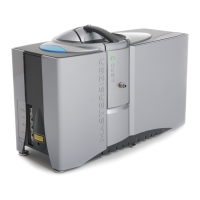Chapter 4 Making measurements
Page 4-46 MAN 0474
Result range
(continued)
Note: The software will automatically flag the use of any
range reduction facility to preserve the integrity and tracea-
bility of the results.
Result type Set the result type for the particle size distribution - choices
are Volume distribution (recommended), Surface area dis-
tribution or Number distribution. By default the Mastersizer
measurement is fundamentally a measurement of the volume
distribution - transforming the result into number distribution
is a mathematical process that may amplify any error in the
original result. Small volumes of small size particles may be
transformed in to significant numbers of particles. Use the
size range controls above to limit this effect.
Extend the result Result extension can be used to extend the Mastersizer
result to sizes beyond 3500μm.
To enable a result extension, first click the Extend with an
External Result option. Then, click the Edit External
Result… button to open the External result editor window.
To enter the size band data to add to the Mastersizer result;
use the control icons at the top of this Editor window to add
or remove size bands, as required.

